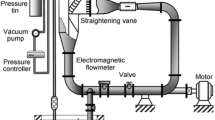Abstract
Experimental and numerical investigations on the effect of transverse surface topography on cavitation erosion were performed. Specimens made in 45 steel with different transverse surface topographies, which were finished by milling under different processing parameters respectively, were tested in the water-tunnel experimental devices. Scanning electronic microscope and photon microscope were adopted to analyze the cavitation erosion degree on the specimens’ surface after 120 minutes’ tests. Results showed that the degree of the cavitation erosion was affected by the distribution and shape of the surface topography, and the interval between the topography units, which represented the topographies’ distribution, played a more important role than the shape of the units. Numerical simulation results of the flow over flat surfaces with transverse topographies, which were triangle or trapezoid and proportional spacing, were obtained to explain the effect of the transverse surface topographies on cavitation erosion. The variation of the average pressure distribution in the vicinity of the surface and pressure fluctuation caused by the surface topographies both affect the collapse behavior of the cavities which usually exist in the flow. Experimental and numerical results indicate that the degree of cavitation erosion on the specimens in the water-tunnel can be reduced by proper topography design.
Access this chapter
Tax calculation will be finalised at checkout
Purchases are for personal use only
Preview
Unable to display preview. Download preview PDF.
Similar content being viewed by others
References
Huang, J. T., 1991, Theory and Application of Cavitation and Cavitation Erosion, Tsinghua University Press, Beijing.
Trevena, D. H., 1987, Cavitation and Tension in Liquids, IOP Publishing Ltd, Great Britain.
Bourne, N. K., Field, J. E., 1995, “A High-speed photographic study of cavitation damage,” J. Appl. Phys. 78(7), pp.4423–4427.
Brujan, E. A., Keen, G. S., Vogel, A., et al, 2002, “The Final Stage of the Collapse of a cavitaion bubble close to a rigid boundary“, Physics of Fluids, 14(1), pp.85–91.
Knapp, R. T., Daily, J. W. and Hammitt, F. G., 1981, Cavitation, Water Conservancy Press, Beijing, China.
Arndt, R. E. and Ippen, A. T., 1968, “Rough surface effect on cavitation inception,” Journal of Basic Engineering, 90, pp.249–261.
Chang, J. C., Huang, S. B. and Lin, C. B., 2006, “Effects of inlet surface roughness, texture, and nozzle material on cavitation,” Atomization and Sprays, 16, pp.299–317.
Lecoffre, Y., 1999, Cavitation Bubble Trackers, A.A. Balkema Publishers, USA.
Nie, M. X., 2001, “Cavitation prevention with roughened surface,” Journal of Hydraulic Engineering, 127(10), pp.878–880.
Ahmed, S. M., Hokkirigawa, K., Ito, Y., et al, 1991, “Scanning Electron microscopy observation on the incubation period of vibratory cavitation erosion,” Wear, 142, pp.303–314.
Preece, C. M., 1979, Treatise on Materials Science and Technology, Academic Press, New York.
Xu, W. X., 1990, “Calculation of motion of a single bubble in pressure fluctuation field,” Journal of Hydrodynamics, 5(1), pp.118–121.
Hammitt, F. G., 1980, Cavitation and Multiphase Flow Phenomena, McGraw Hill Inc, USA.
Author information
Authors and Affiliations
Editor information
Editors and Affiliations
Rights and permissions
Copyright information
© 2009 Tsinghua University Press, Beijing and Springer-Verlag Berlin Heidelberg
About this paper
Cite this paper
Li, Y., Xu, Z., Chen, H., Wang, J., Chen, D. (2009). Effect of Transverse Surface Topography on Cavitation Erosion. In: Luo, J., Meng, Y., Shao, T., Zhao, Q. (eds) Advanced Tribology. Springer, Berlin, Heidelberg. https://doi.org/10.1007/978-3-642-03653-8_111
Download citation
DOI: https://doi.org/10.1007/978-3-642-03653-8_111
Publisher Name: Springer, Berlin, Heidelberg
Print ISBN: 978-3-642-03652-1
Online ISBN: 978-3-642-03653-8
eBook Packages: EngineeringEngineering (R0)




